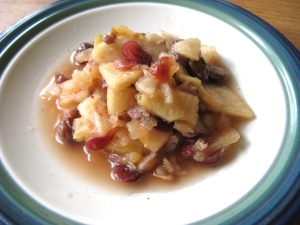 I’ve got a medium sized crop of tomatoes this year. Some varieties haven’t done much, like the Green Zebras in the photo, but others have been prolific, like the dark red Indigos in the photo. Of course, the bright orange and sweet garden-candy Sungolds, are tasty and prolific as usual. The yellow ones are Yellow Mortgage Lifters. This photo is of one tray of tomatoes about to be started in the dehydrator.
I’ve got a medium sized crop of tomatoes this year. Some varieties haven’t done much, like the Green Zebras in the photo, but others have been prolific, like the dark red Indigos in the photo. Of course, the bright orange and sweet garden-candy Sungolds, are tasty and prolific as usual. The yellow ones are Yellow Mortgage Lifters. This photo is of one tray of tomatoes about to be started in the dehydrator.
It’s nice to dry any surplus tomatoes I have, because I love having dried tomatoes during the winter. My favorite way to use them is in soups. I simply grab a couple of handfuls of dried tomatoes and throw them in a kettle of water. They soften up and the water leeches out a nice tomato flavor for the broth. Then I throw in whatever else I want, often string beans and summer squash from the freezer.



 Kevin Costner’s character, Ray Kinsella, in the 1989 movie
Kevin Costner’s character, Ray Kinsella, in the 1989 movie  I recently tried a new base material for lactofermentation, apples. This was the first time I have tried fermenting fruit. Although I was warned by a friend that I wouldn’t get good results because the apples weren’t crisp fall apples, I already had the apples and decided to give it a try. I’m glad I did. This chutney has now mellowed into a delightful and well-balanced blend of flavors: salty, sweet and sour. It’s received good reviews from friends.
I recently tried a new base material for lactofermentation, apples. This was the first time I have tried fermenting fruit. Although I was warned by a friend that I wouldn’t get good results because the apples weren’t crisp fall apples, I already had the apples and decided to give it a try. I’m glad I did. This chutney has now mellowed into a delightful and well-balanced blend of flavors: salty, sweet and sour. It’s received good reviews from friends.
